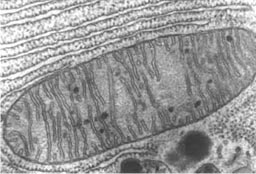
MITOCHONDRIA
[Sub topic of Disease Process of ALS]
Related recent news releases
Mice Show How Mitochondria Flow in Nerve Cells
Mitochondrial Approaches Towards Treating ALS
 |
|
Mitochondria are the power plants inside cells |
Mitochondria fuel the metabolic reactions that create and maintain all other structures of the cell. These cellular fueling pumps are implicated in such neurodegenerative diseases as Parkinson’s and Alzheimer’s. Mitochondria are especially critical to the motor neurons that die in ALS, as these cells must meet extraordinary demands for cellular energy. Researchers report damage to the mitochondria in the cells of mice with mutated SOD1. This mutated protein associated with some cases of inherited ALS may indeed form abnormal deposits within these crucial cell organelles. A common means to solving many neurodegenerative problems including ALS will certainly come to light by knowing more about the role of mitochondria.
What are mitochondria? Mitochondria are the power plants of all animal cells. They fuel the metabolic reactions that create and maintain all other structures of the cell. These self contained organelles must, in the case of motor neurons, sustain the amazing capacity of a single cell to span from the spinal cord all the way to a person’s fingers and toes.The mitochondria also orchestrate the orderly death of cells (see also Cell Death and ALS). Mitochondria play a role for removing cells when they are not needed in the growing animal, or later, in an adult, if cells are not working properly.
Mitochondria move charged particles across their membranes to produce cellular fuel. This electron transport chain produces the currency of cell sustenance, a fuel molecule called adenosine triphosphate (ATP). Mitochondria also control the cellular content of calcium ions. In nerve cells, calcium is particularly important in producing the signals that contract muscles and produce thoughts.
How are Mitochondria Affected in ALS? In ALS, evidence is building that actions on or originating in the mitochondria may be an important part of the disease. Changes in the mitochondria can be detected before one can find a physical change such as hind limb weakness in mice.A role for mitochondria in ALS may explain why SOD1 mutant proteins selectively damage the motor neurons. Some recent studies suggest that mutant SOD1 protein builds up in the mitochondria, unlike normal SOD1 protein which is present throughout the cell but may not be in the mitochondria in healthy cells. This possible shift of mutant SOD1 into the mitochondria may be occurring in motor neurons and not in the liver and kidneys, some evidence suggests.
Mitochondria, as stated earlier, are also involved in the process called apoptosis, a deliberate removal of cells. Some investigators have found that mutant SOD1 attaches to key proteins involved in the cell death process further implicating mitochondria and apoptosis in ALS.
Frank physical damage to the mitochondria is evident in mice with some of the known SOD1 mutations. First, the organelles swell, then they develop empty spaces. Normal mitochondria consist of tightly folded membranes that provide a platform for the metabolic reactions that generate cellular fuel. After the empty spaces appear, the inner membranes of the mitochondria break apart.
The empty spaces appear in mitochondria early in the disease process in the mice. Other researchers have determined that a very early change in mice with mutant SOD1 is a slowing of mitochondrial reactions that provide energy to the cell.
ALSA funded researchers are working on all of the intriguing possibilities for a critical role of the mitochondria in ALS. It should be noted that these cellular fueling pumps are also implicated in such neurodegenerative diseases as Parkinson’s and Alzheimer’s.
